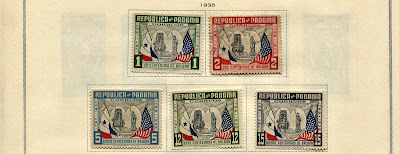Collectors in the United States have huge, perhaps
excessive, interests in the stamps of Panama, owing mainly to the Canal and the
history surrounding it. Because much has been written about the topic and
available online (see abbreviated list at the end of this post), I’ll forgo
adding my bit to the existing lore.
Instead, I’ll comment about postal specimens, of which
four full pages are showing in the Panama supplement scans (see below).
What exactly is a postal specimen? The broadest
definition is – an authentic stamp or postal stationery indicium with the word
“specimen” overprinted, punched or hand-stamped across it, thereby legally
voiding it for postal use. Specimens do have practical uses, though. Among
them:
--instructional aids for new postal workers learning proper
stamp counting methods.
--detection of forgeries.
--favors for dignitaries.
--preservation in archives.
--informational distributions to other UPU member
countries.
--publicity in the press
--exhibition
displays.
--preventing leakage of mint stamps to the philatelic
market (e.g., League of Nations).
Sometimes the word “cancelled” serves the invalidating
function. “Specimen” in other languages does the same: muestra
(Spanish), spécimen or annul (French), monster
(Dutch), Muster (German) or Образец (Russian, ‘Obrasetz’).
I have not intentionally collected specimens but, when
they’re reasonably priced, I’ve picked them up. They often cost dearly. For
more common stamps, they usually have higher prices than those valid for
postage. For rare stamps, specimens are normally cheaper than the actual stamp.
Those showing in my Panama supplement pages, being of the ordinary sort, are
several times more expensive than the same stamps without the overprints.
The Panama specimens have punched holes as well as
varieties of red ink overprints. All are from the 1924 definitive series
featuring the Arms of Panama, Scott #s 234 thru 243. The typewritten numbers on
small pieces of white paper (see above) accompanied the stamps when I bought
them and were probably provided by the American Stamp Note Company to identify
varieties of overprints. These little papers sometimes appear with specimens being
sold at auction.
Some collectors worry about the correct placement of specimens
in Big Blue (BB). Technically, BB is a postage stamp album and, technically,
specimens are no longer valid postage stamps. So, they don’t qualify. But
they’re interesting to collect. Normally I put specimens and other philatelic adiaphora
on blank sheets and insert them at the end of the supplement pages. There they
seem happy in the company of locals, proofs, etiquettes, charity Cinderellas,
and even furniture manufacturers’ stamps where their presence is neither demanded
nor forbidden, as it would be if they were placed in designated album spaces.
Essays and die proofs serve some of the same functions as specimens, but they lack the identifying word “specimen”. Unlike specimens, they are not debased authentic postage stamps. Essays are proposed stamp designs that may or may not be adopted.
Proofs are pulled from the plates as test runs before
production, thereby allowing engravers to check their work and test colors. They’re
usually printed on India paper or card stock; they lack gum and perforations. A
final proof is often pulled for the printing company’s archives.
League of Nations
specimens have an unusual purpose, as explained on the page from my League
album (below). For security reasons, the League prohibited the sale of mint
stamps to the public; the first issues were sold to collectors only as CTOs.
Later, they used red “specimen” overprints for the same reason. After the
League was disbanded (1946) remaining mint stamps were sold in the philatelic
market.
Because of their many
specimens, proofs and essays, Panama’s stamps provide a good opportunity to study this
facet of philately. But there is, as always, the danger of fraud. Bogus overprints
are easily applied to mint stamps. Essays may be artists’ renditions never
submitted for consideration and produced long after the authentic stamps were
issued. So-called proofs are sometimes merely photographic reproductions. These
fakes, although deceitful, are not precisely forgeries or counterfeits because
they do not pretend to be valid postage. So be extra careful.
Panama stamp census: 152 in
BB spaces, three tip-ins, 99 on supplement pages, 94 specimens.
Websites with information
about Panama’s stamps.
(1)
http://bigblue1840-1940.blogspot.com/2014/12/ClassicalStampsofPanama.html
(3)
https://postalmuseum.si.edu/exhibition/international-philately-americas-central-america/panama
(4)
https://daily.jstor.org/how-a-postage-stamp-may-have-helped-create-the-panama-canal/
(5)
http://icollectpanama.com/collection/panama_postal_history.html
Note:
all illustrations in this post are from my personal collection except for the rejected
essay, which came from eBay.












































No comments:
Post a Comment